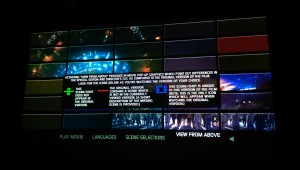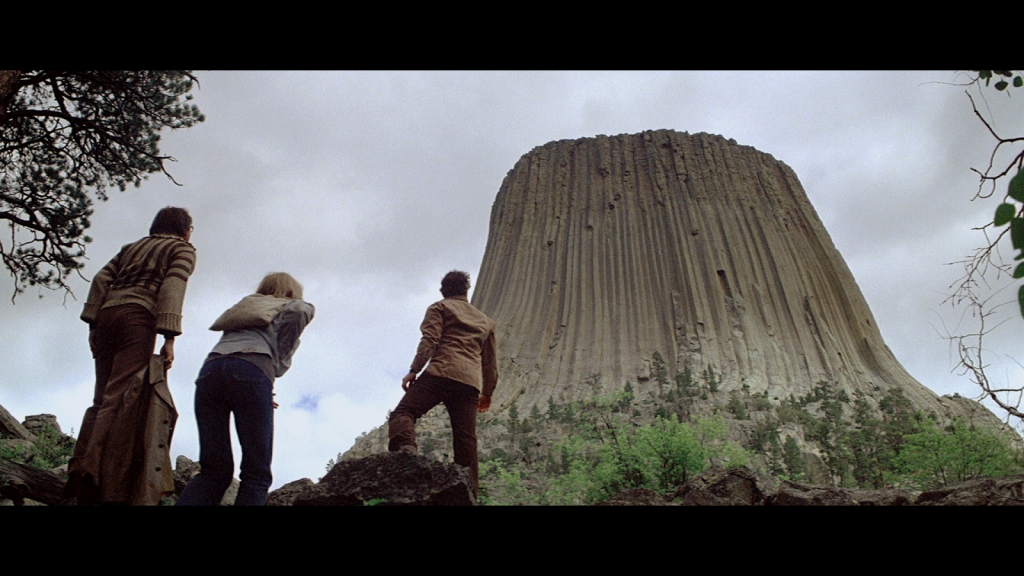Did you watch the Oscars last night? Me neither.
Well, I shouldn’t assume this about you, so I’ll only speak for myself: I can’t sit through that popular variety show, as sophisticated as a musical revue at a retirement home – always cutting away to a primped audience giving itself standing ovations all night long. Yet, around the annual hysteria this week, something caught my eye, a useless but funny statistic shown in the above clip: Spielberg gets thanked more than God at the Oscars.
So, needing to crash after a long weekend of filming and editing, during Oscar time I dove into a re-mastered Blu-Ray of Spielberg’s Close Encounters of the Third Kind, because he is more important than God, or the Oscars for that matter. The news was pretty clear about that.
I’m embarrassed to admit – despite being uptight about formalities, when it comes to watching cinema – after a few minutes I got that nagging thought, “Do I really want to watch this?” The mid-70s optical effects were just waiting to be mocked by what’s possible today; and I’d seen the film before, not especially impressed as a kid. Would it be different?
Well, Spielberg must be better than God for a reason. With grown-up acumen now, and a patience for the fundamentals of cinema, Close Encounters of the Third Kind became something of a revelation to me tonight. While it’s fresh in my mind (the credits just rolled), I thought I’d jot out what I learned from my close encounter with Spielberg.
7 FILMMAKING LESSONS FROM STEVEN SPIELBERG’S CLOSE ENCOUNTERS
1. Don’t always take turns. In the real world, people don’t. Amateurs might need to, if they’re struggling to remember lines and find their place. But a good film overlaps stuff, just like life. There’s a great scene early in the film when air traffic controllers are scrambling about a UFO sighting, and three of them (rack-focused) are saying totally different, independent things at the same time. Community college drama professors might say it’s poorly played because it’s hard to follow and doesn’t advance the plot with information, but when Spielberg directed the scene that way, it felt true. Another example: when we’re introduced to the domestic family life of the main protagonist played by Richard Dreyfuss, there are half a dozen things going on at once: the television, a math lesson, a sibling bashing a doll into pieces, Teri Garr making plans, etc. It’s crazy, and it’s real. It might seem like an obvious technique, but at the extent I just saw it, I swear it felt like avant-garde theatre – even absurdism. These days, Hollywood is churning out bland, fake, egomaniacally scripted behavior. Spielberg was onto something in the 1970s, and it never stuck.
2. Don’t obsess over lens imperfections. When you shoot anamorphically, cool things happen. You get authentic lens flares, which J.J. Abrams can’t hold a candle to (just as he over-uses them tastelessly). The necessity for diopters makes focusing complicated and variably blurry, with vignetting. Motion across the frame feels weirdly warped. All of these things are magical, not just because they’re vintage, but because they announce that you are watching more than video: it’s the art of cinema. We don’t go to art museums expecting photo-realism on every canvas, do we?
3. Hold the camera still, or be smooth when you move. This is a simple one. Lots of “indie” morons still think (tragically) that shaky camerawork is edgy and dramatic. It sure is, almost never. Spielberg’s camera movements were formal, majestic, ethereal and patient. He spent more than a Hollywood minute framing richly textured compositions, then allowed character action to happen inside that frame, rather than bouncing between angles, in that blandest volley of conversation-tracking we see almost always. It doesn’t matter whether you need to lay out dolly tracks for nearly every shot, or just mount a Blackmagic Pocket on a cheap three-axis motorized gimbal, but when you’re too kool for skool, and you whiplash your audience around, you’re just being lazy, making up a stylistic excuse, and kind of an asshole.
4. Use drugs. Kidding. But I remember reading an anecdote some years ago, how Spielberg got inspired to make this film after parking his car on a hill with a view over the Los Angeles basin, laying on the hood, and seeing the city lights upside-down … after smoking dope. I never touched da ganja, and never will (though it’s legal where I live now); but come to think of it, after watching this film, a theme emerges: it’s not really an examination of U.F.O. culture, or a veneration of scientists, or even a character-driven drama. It feels mostly like a sequence of tableaus, each conceived because of a purely visual idea. It’s as if Spielberg had a bunch of visual things to say, then found within himself a story to stitch them together, as a secondary priority. Dated as this film may be, taken incrementally, there are many dream-like visual compositions, the sort you can only ruminate slowly over periods of years (and yeah, maybe getting stoned). Once again, I’ve gotta grumble: these days, we’re hardly seeing this visual auteur priority. What happened?
5. Obscure details. They’re not important. You’d think that a film about spaceships from the mid-1970s would look laughably cheap. Star Wars is starting to look that way, if we’re honest. But with Douglas Trumbull as his friend and foe, Spielberg here conceived of alien spaceships as simply bright lights. It’s more mysterious, more beautiful, and ages gracefully. Indeed, a lore behind the scenes is that Spielberg got pressured into showing the interior of the spaceship, but later regretted how that removed a sense of mystery (and now, it does look ridiculous decades later). Which leads to…

6. Commit to your edit, and move on. You could argue that Martin Scorsese is the greatest film auteur in the medium’s history (I’d agree), but ever notice, he doesn’t do “director’s cuts”? This film might have gotten better after scrambling through a “special edition” and on to a “director’s cut,” but there’s virtue in fighting for the right film, without compromise – another way to say this is, you’ve got only one chance to get it right. You can fiddle with your old work forever, but life’s short.
7. Cinema is a symphony. That word “symphony” is more than just a preface to numbered works by classical European composers. A symphony is an intimate collaboration, a inextricable combination of instruments, and when combined with images (to use a loaded German term of art), a gesamtkunstwerk. Composers are not garnishes to be brought in after a locked-down edit, scribbling ditties that perfectly match every intended emotion onscreen. Music scores are what the left hand is writing while the right hand is writing the script. John Williams notoriously wrote this film’s score in close collaboration with Spielberg, and its closing sequence (as in E.T.) is through-composed music that commands the cutting rhythms of the film. Spielberg’s deep respect for music is manifested in that five-note signal to the aliens we know so well, paired with the Kodály Method’s hand signs for sounding out music. It’s an integral part of the plot.
